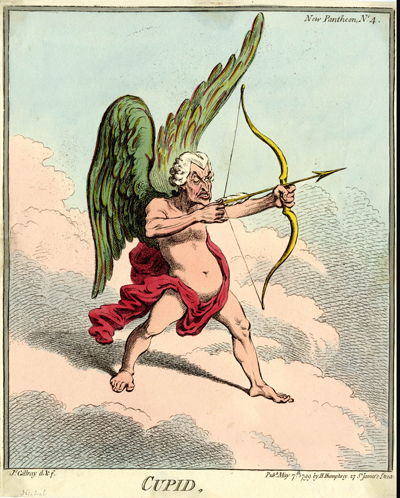Cupid
This is the fourth of six prints from the New Pantheon of Democratic Mythology portraying Whig statesmen as figures from popular mythology; in this case the Whig MP John Nicolls as (blind) Cupid. For more about the series in general, see my commentary on the frontispiece to the New Pantheon of Democratic Mythology.

© Trustees of the British Museum
Like most of the prints in the New Pantheon of Democratic Mythology Cupid falls into the general category of portrait caricature, a full-length caricature of John Nicolls against a minimal background—in this case the blue sky and white clouds appropriate for a winged Cupid. It parodies the formal portraiture of the day in portraying Nicholls as a classical figure. But in this case, the comparison denigrates rather than exalts its subject by the utter incongruity of the caricatured treatment.
Cupid was the god of love and desire, and has a long history in art. He is sometimes portrayed as a beautiful youth; but more often, after the Renaissance, as a chubby baby-like child. He is usually winged to emphasize both the speed and ubiquity of love, and less often as blind, suggesting the unaccountability of love's objects.
Gillray's portrait of John Nicholls is a virtual anti-Cupid. Instead of being young and beautiful, he is old and ugly. Instead of flying gracefully like so many cherubic amorini, Nicholls stands awkwardly with boney legs splayed and a protruding belly. And obviously he knows nothing about archery, drawing the arrow back incorrectly with his fingers beneath rather than around the shaft. This is consistent with the ministerial view of Nicholls who is described in Notes to the Poetry of the Anti-Jacobin as "blind of one eye and altogether remarkably ugly, His delivery was ungraceful and his action generally much too vehement."
Never loathe to take advantage of personal defects, this was not the first time, Gillray made cruel allusion to Nicholl's partial blindness. In his portrait of Nicholls in French Habits, Nicholls is shown seated beneath the figure of "blind justice" holding the staff of the Juge de Paix with its prominent engraved eye.
Sources and Reading
- Commentary from the British Museum on Cupid.
- Draper Hill, Mr. Gillray The Caricaturist, 1965, p. 81n.
- "Cupid," Wikipedia
- "John Nicholls (MP)," The History of Parliament
- Thomas Wright and R.H. Evans, Historical and Descriptive Account of the Caricatures of James Gillray #234
- Thomas Wright and Joseph Grego, The Works of James Gillray, the Caricaturist; With the History of His Life and Times, p. 259.
Comments & Corrections
NOTE: Comments and/or corrections are always appreciated. To make that easier, I have included a form below that you can use. I promise never to share any of the info provided without your express permission.